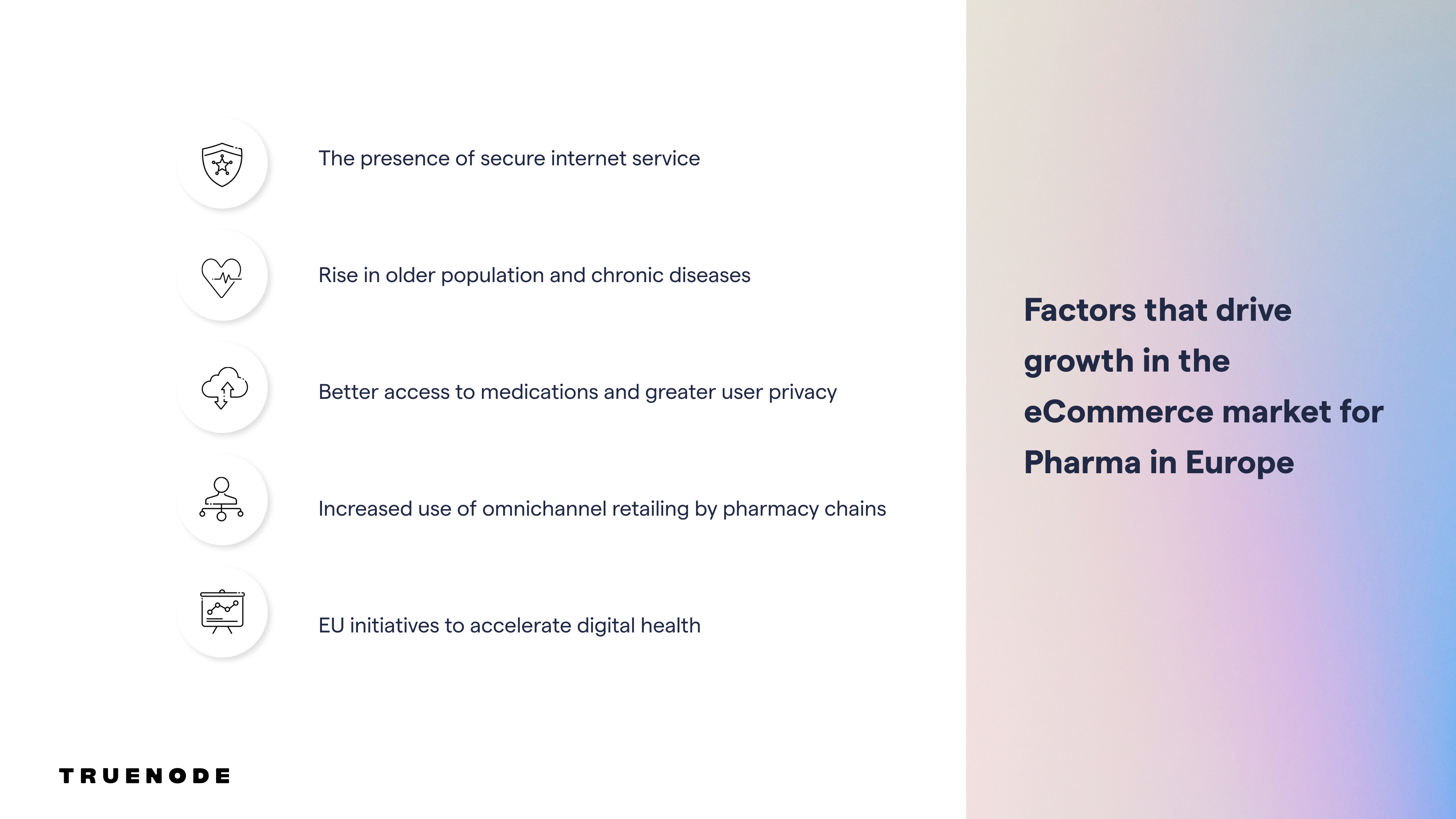Article

The Rise of Pharma eCommerce and How to Build a Scalable Online Pharmacy
The growth of ecommerce in the pharma industry has the potential to disrupt traditional drug distribution models and create new opportunities for both consumers and businesses.
In 2023, the pharmaceutical and health e-commerce market is projected to expand significantly. Despite this growth, companies in the industry will face a variety of challenges such as intense competition, regulatory compliance, data privacy, and the need for secure and user-friendly online pharmacies.
According to TechNavio’s report, the pharma e-commerce market in Europe is estimated to grow at a CAGR of 15.47% between 2022 and 2027.
Factors that drive growth in the eCommerce market for pharma in Europe
-
The presence of secure internet service
European consumers now have the convenience of a secure online service that enables them to purchase medications with ease. This provides a simple and straightforward way for customers to make their purchases quickly and securely, providing peace of mind when ordering medicines online.
-
Rise in older population and chronic diseases
The life expectancy of people in the EU is higher than in other developed countries, leading to an increase in the geriatric population and prevalence of chronic illnesses such as diabetes, arthritis, cancer, obesity, heart disease, asthma, and COPD. This has resulted in increased dependency on families and caregivers and a need for medicines at the correct time. Consequently, the increasing awareness of online pharmacies and the convenience of ordering medicines online is expected to drive market growth.
-
Better access to medications and greater user privacy
Online pharmacies provide customers with greater access to medications they need, as well as more privacy when filling prescriptions. Customers can fill prescriptions before they’ve even left the doctor’s office, or right after hanging up from a telemedicine appointment, and get refills just as conveniently. This makes the entire process more comfortable and private.
-
Increased use of omnichannel retailing by pharmacy chains
As the use of online pharmacies increases, retail pharmacy chains in Europe are now focusing on integrating omnichannel technology into their operations rather than expanding their physical stores, in order to capitalize on the rapidly growing market. Smartphones and tablets have become essential for the development of omnichannel retailing, allowing customers to access retailers and their products quickly.
-
EU initiatives to accelerate digital health
The increasing number of governmental and non-governmental initiatives to promote digital innovation and convenience for consumers also drives the growth of the market. For instance, in 2020, the European Commission adopted the Pharmaceutical Strategy for Europe aiming to create a future-proof regulatory framework and to support the industry in promoting research and technologies that reach patients, addressing market failures. Moreover, the revised EU pharmaceutical package is planned to launch in Q1 2023. This initiative is in line with the European Digital Strategy.

eCommerce challenges for the pharmaceutical industry
-
Integrating multiple areas to build end-to-end solutions
In the past, pharma companies were responsible for manufacturing, while the key areas of customer journey such as distribution, prescription, digital marketing, digital experience, ecosystems and partnerships, were taken over by other businesses.
With the growth of Pharma eCommerce and D2C, pharma companies need to build an effective end-to-end platform containing every step of the value chain.
-
The market is getting more competitive
The pharmacy industry is now facing intense competition among e-commerce companies, warehouse club retailers providing same-day pharmacy deliveries, and large chain pharmacies gaining more market share.
Developing a user–oriented solution that offers an excellent user experience and is able to rapidly adjust to the continuous transformation is essential to remain competitive.
-
Regulations barriers and geographic restrictions
The pharmaceutical industry is highly internationalised, allowing for the production and distribution of products in different markets. However, this also brings with it the challenge of meeting the legal and ethical requirements for the production of pharmaceuticals and drug prescription. Additionally, geographic restrictions and regulations can create barriers to eCommerce in the pharmaceutical sector, as most online purchases are distributed from regional and national suppliers.
Building a scalable patient-centric end-to-end solution to unlock the emerging opportunity for the pharma industry
The complexity of the process of building end-to-end solutions has been largely impacted by various challenges, including regulatory issues, lack of expertise in multiple areas, and usage of legacy systems that are rigid and incompatible with new tech.
However, these challenges can now be managed with more ease as new regulatory frameworks open up the path, and companies can adopt new technologies and strategies that advance eCommerce agility, making it easier and less costly to adapt to the changing eCommerce market.

Adopting headless commerce to enable flexibility and business scalability
Advanced technologies such as composable solutions can add value beyond eCommerce integration to legacy systems, allowing pharmaceutical companies to tailor experiences to their customers’ exact needs in ways that are flexible and easy to scale.
Headless commerce enables the use of ready-made commerce building blocks to create or supplement existing infrastructure and run them at scale.
These solutions are based on the MACH principles of microservices-based, API-first, cloud-native, and headless which provide a modular and composable environment for e-commerce platforms to embrace innovation, allowing them to respond quickly and with less risk.
Businesses are taking advantage of headless technology to separate the customer-facing frontends from the backend, where data such as pricing, products, promotions, orders, and delivery are stored. This gives them the flexibility and speed to create shopping experiences. In this period of economic uncertainty, having this kind of control and agility to meet customers’ needs now and in the future is more essential than ever.
To learn more about the advantages of headless commerce, read our article here.
Overall, e-commerce is a prominent opportunity that’s quickly becoming a necessity for pharma companies to future-proof their businesses.
Are you looking for innovative solutions to upgrade your online pharmacy?
Our team of experts can help you create and implement composable solutions or migrate your monolithic e-commerce to headless e-commerce platform. With our comprehensive approach, we can provide you with the best strategies and solutions to ensure success.
Find out how we can help you and book a slot to scope your project with us!






